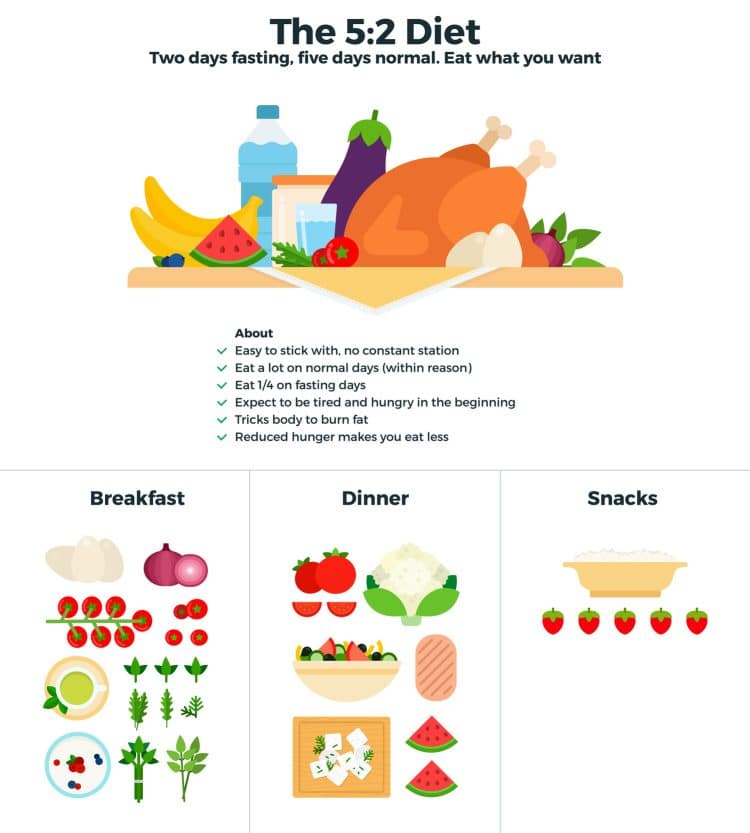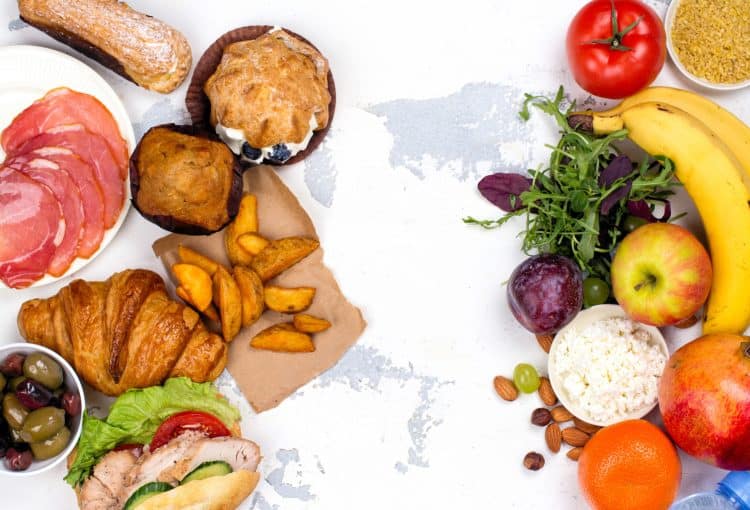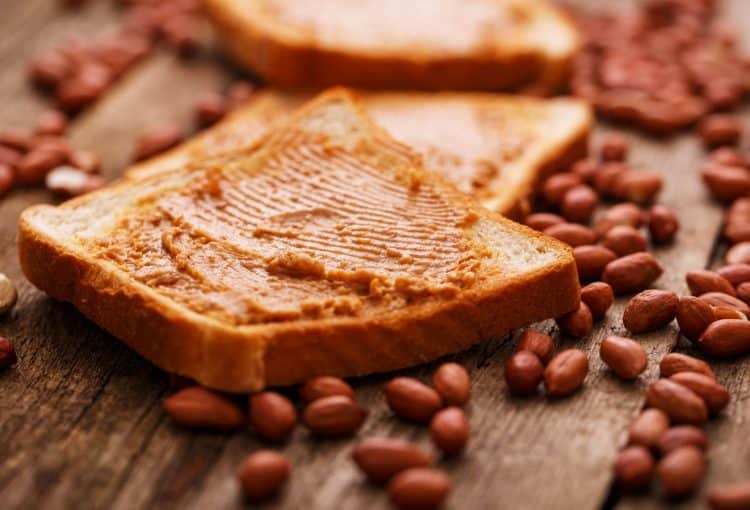Fasting has gained popularity in the last few years due to its health-boosting benefits. Doctors suggest different fasting diets for people struggling with obesity and related health problems. Also, many turn to fasting to stay in shape and maintain a healthy lifestyle.
Intermittent fasting (IF) has become a preferred diet for many, but each program has specific nuances. One of these fasting plans is the 5:2 diet. This article will help you better understand its workings and benefits.
What is a 5:2 Diet?
A 5:2 diet is a form of intermittent fasting that requires you to fast for two days a week or restrict yourself to 500–600 per day; follow your regular diet for the remaining five days. Popularized by the famous British journalist Michael Mosley, the 5:2 diet aims to create a weekly calorie deficit, which can help lose weight.
The 5:2 gained popularity because it is easier for beginners to follow. In this, people choose whichever fasting days work for them, given that one non-fasting day separates the two.

Benefits of Intermittent Fasting
Intermittent fasting has become popular in the healthcare industry, particularly among people dealing with weight gain [1]. IF combined with exercise can benefit people struggling with obesity and eating disorders. Studies have shown that intermittent fasting can cure or prevent heart disease, stroke, aging, type 2 diabetes, etc. [2]
Here is a closer look at some benefits of the 5:2 IF diet.
Easy To Follow
Most intermittent fasting plans can be challenging for beginners, who might initially experience nausea, headaches, and general discomfort. It can demoralize them and make them quit fasting.
Beginners on a 5:2 diet program can comfortably incorporate two fasting days into their week. Plus, they can consume 500-600 calories on their fasting days. Many people can also use the 5:2 diet as a stepping stone to much more complex fasting regimens.
Helps Manage Blood Sugar

Since obese people generally have high insulin resistance, they are at a higher risk of developing type 2 diabetes. Intermittent fasting can improve insulin resistance, which helps reduce blood sugar levels.
Fasting for extended periods can cause your insulin levels to drop, and the periodic insulin spikes are regulated. During a fast, you don’t eat anything that spikes insulin, helping manage your blood sugar levels and lowering the risk of type 2 diabetes. [4][5]
Benefits From Other Similar IF Plans
4:3 fasting is another IF plan similar to 5:2 fasting. The 4:3 diet requires fasting thrice a week. It creates a bigger weekly calorie deficit than the 5:2 plan. Plus, these plans can cure certain eating disorders.
People uncomfortable with daily intermittent fasting plans can use 5:2 and 4:3 diets to get accustomed to fasting. Research suggests fasting a few days a week can improve heart health, regulate cholesterol levels, prevent aging, boost metabolism, and enhance cellular health. [6][7]
Fasting two days a week can also have many other benefits, like reducing inflammatory markers, promoting cell repair, and improving gut health. Fasting can also boost metabolism, helps control hunger, and keep you satiated for longer. [9][10]
How To Follow A 5:2 Diet For Weight Loss
Many are attracted to fasting due to its weight loss benefits; the 5:2 diet is no different. It can be an excellent plan for overweight people fasting for the first time.
The two-day fast is convenient, and you can eat 500-600 calories on fasting days. You can choose any two days of the week as long as there is at least one non-fasting day between them. Most prefer to fast on Mondays and Thursdays with two or three small meals. Plus, dieters can work out on regular eating days for faster results.
The calorie restriction during fasting can begin the “ketosis” process, where your body breaks down stored fat into energy. [8]
What To Eat On Fasting Days
After deciding to follow the 5:2 diet, you need to figure out what you’ll eat during the fasting days. You should choose low-calorie satiating foods that can make you feel full for longer. [11]

Meal Pattern for Fasting Days
You can consume 500-600 calories on your fasting days on a 5:2 diet. Choose between two meal programs based on your preferences:
- Two Meal Plan: Eat two small meals during fasting days.
- Single Meal Plan: Eat a single meal and fast for the rest of the day.
Add these foods to your fasting days:
Fiber & Vegetables
Vegetables are low in calories and packed with nutrients. They are also high in fiber, making you feel satiated for longer — for example, green beans, broccoli, carrots, capsicum, zucchini, etc.
Soups
Are you struggling with low-calorie meals? Soups are your best bet. Soups and broths are protein and nutrient-rich and don’t spike your calorie intake. Also, studies suggest that soups can help us stay satiated for longer. [12]
Lean Protein
Lean proteins such as egg whites and chicken breast are excellent choices for people who are fasting and want to consume nutritious, low-calorie foods. Proteins are your muscles’ building blocks, so it is necessary to have the right amount of proteins while fasting. Vegans can go for soy products like tofu and soy chunks.

Water
As the 5:2 diet is not a dry fast, you can drink water on this plan. Aim to consume around four liters of water each day to avoid dehydration. Also, water performs many vital functions, including body temperature regulation, blood purification, etc.
Coffee
Some feel tired and lethargic while fasting. Zero-calorie coffee is a wonderful way to get an energy boost. Additionally, drinking coffee while fasting can help you better manage your hunger. Take a look at some of the best coffee creamers for intermittent fasting.
Dark Berries
Berries are a delicious food option for your fasting days. These small, flavorful taste bombs are filled with antioxidants. Berries are low in calories and can add flavor to plain yogurt and salads.
People can combine the foods mentioned above to make a meal that suits their tastes.
Foods To Avoid During Intermittent Fasting
Avoids these foods while intermittent fasting as they can disrupt or complicate your fasting process:
Fats in Excess
When consumed in moderation, fats are beneficial. A 150-pound individual who wishes to lose weight should consume roughly around 34-68g of fat per day. If you have a target calorie number in mind, 20-35 percent of those calories should come from fat.
Refined Carbohydrates
Refined carbohydrates like pasta, flour, bread, etc., contain sugars and processed grains. Including these in your fasting-day meals will bump your calorie intake and leave you feeling hungry and unsatisfied.
Processed Foods
Like refined carbohydrates, processed foods are a strict no-no during fast days. Processed foods like chips, chocolates, soft drinks, etc., are filled with calories and contain no extra nutrients.
How To Eat On Regular Days
One of the best things about the 5:2 diet is that you can eat normally five days a week. Although the 5:2 diet does not impose any restrictions, consuming a healthy and balanced diet is preferable during your eating days. Additionally, you should ensure you stay below the 500-600 calories permitted during the fasting days.
Sample 5:2 Diet Meal Plan
Here are some meals you can use during the 5:2 fasting days. (There is no calorie restriction on the eating days.)
- Breakfast: A slice of brown bread with low-fat peanut butter (approximately 150 calories).
- Lunch: A small bowl of chicken salad made with cucumbers and tomatoes (approximately 200-250 calories).
- Dinner: Chicken soup with egg (about 200 calories).

How To Deal With Uncontrollable Hunger and Sickness
The 5:2 diet can be difficult for people fasting for the first time. Some may even initially experience uncontrollable hunger. For times like these, try to distract yourself by keeping busy with work or other errands.
On the other hand, you should immediately break the fast if you feel sick. Also, start fasting one day a week to get accustomed to fasting.
Who Should Avoid Intermittent Fasting
Intermittent fasting can be an excellent way to lose weight and feel better, but it’s not for everyone. If you have any of the following conditions or circumstances, it’s best to avoid intermittent fasting:
- Eating disorders
- A history of heart disease and type 1 diabetes
- People who are malnourished or underweight
- Pregnant or breastfeeding women
FAQs
Is the 5:2 diet safe for teens?
No, the 5:2 diet is not safe for teens, as they are in their growth phase, and following 5:2 can hinder their growth.
Is it healthy to do intermittent fasting every day?
No. Prolonged daily intermittent fasting can be harmful, and people must do it after consulting a healthcare professional. Here are some tips for intermittent fasting.
How long does it take to see results from intermittent fasting?
Intermittent fasting results can vary from person to person. Generally, it may take two to ten weeks to see noticeable results.
Conclusion
The 5:2 diet is an excellent fasting plan for beginners. Although the 5:2 diet is relatively safe, you should consult a healthcare professional before trying it.
Notably, the 5:2 diet demands commitment, planning, and discipline. Make healthy food choices on your non-fasting days and engage in regular physical activity to support your overall health and weight loss goals.
Learn more about fasting
- 11 Best Intermittent Fasting Books in 2023 (Review and Ranked)
- 7 Day Water Fast: Your Journey to Rejuvenation and Wellness
- 6 Intermittent Fasting Juice Recipes: Sip Your Way to Success with These Tasty Recipes!
- Eat Stop Eat Intermittent Fasting Decoded: Master Your Metabolism & Lose Weight
- Intermittent Fasting for Weight Loss in Men — The Ultimate Guide
- Fat Loss vs. Weight Loss — Explained!
- Fruit Fasting: The Sweet Path to Wellness
- Foods To Avoid While Intermittent Fasting
References
- “Intermittent Fasting and Obesity-Related Health Outcomes: An Umbrella Review of Meta-analyses of Randomized Clinical Trials – PubMed.” PubMed, 1 Dec. 2021, pubmed.ncbi.nlm.nih.gov/34919135.
- “Cardiometabolic Benefits of Intermittent Fasting – PubMed.” PubMed, 11 Oct. 2021, pubmed.ncbi.nlm.nih.gov/34633860.
- “Short-term Modified Alternate-day Fasting: A Novel Dietary Strategy for Weight Loss and Cardioprotection in Obese Adults – PubMed.” PubMed, 1 Nov. 2009, pubmed.ncbi.nlm.nih.gov/19793855.0
- “Effect of Intermittent Fasting Diet on Glucose and Lipid Metabolism and Insulin Resistance in Patients With Impaired Glucose and Lipid Metabolism: A Systematic Review and Meta-Analysis – PubMed.” PubMed, 24 Mar. 2022, pubmed.ncbi.nlm.nih.gov/35371260.
- “Intermittent Fasting: Is There a Role in the Treatment of Diabetes? A Review of the Literature and Guide for Primary Care Physicians – PubMed.” PubMed, 3 Feb. 2021, pubmed.ncbi.nlm.nih.gov/33531076.
- “The Effect on Health of Alternate Day Calorie Restriction: Eating Less and More Than Needed on Alternate Days Prolongs Life – PubMed.” PubMed, 1 Jan. 2006, pubmed.ncbi.nlm.nih.gov/16529878.
- “Intermittent Fasting and Human Metabolic Health – PubMed.” PubMed, 1 Aug. 2015, pubmed.ncbi.nlm.nih.gov/25857868.
- “Alternate Day Fasting and Endurance Exercise Combine to Reduce Body Weight and Favorably Alter Plasma Lipids in Obese Humans – PubMed.” PubMed, 1 July 2013, pubmed.ncbi.nlm.nih.gov/23408502.
- “Do Intermittent Diets Provide Physiological Benefits Over Continuous Diets for Weight Loss? A Systematic Review of Clinical Trials – PubMed.” PubMed, 15 Dec. 2015, pubmed.ncbi.nlm.nih.gov/26384657.
- “Short- and Long-term Effects of Continuous Versus Intermittent Restrictive Diet Approaches on Body Composition and the Metabolic Profile in Overweight and Obese Postmenopausal Women: A Pilot Study – PubMed.” PubMed, 1 Aug. 2012, pubmed.ncbi.nlm.nih.gov/22735163.
- “Foods With Different Satiating Effects in Humans – PubMed.” PubMed, 1 Oct. 1990, pubmed.ncbi.nlm.nih.gov/2268137.
- “Soup Preloads in a Variety of Forms Reduce Meal Energy Intake – PubMed.” PubMed, 1 Nov. 2007, pubmed.ncbi.nlm.nih.gov/17574705.


